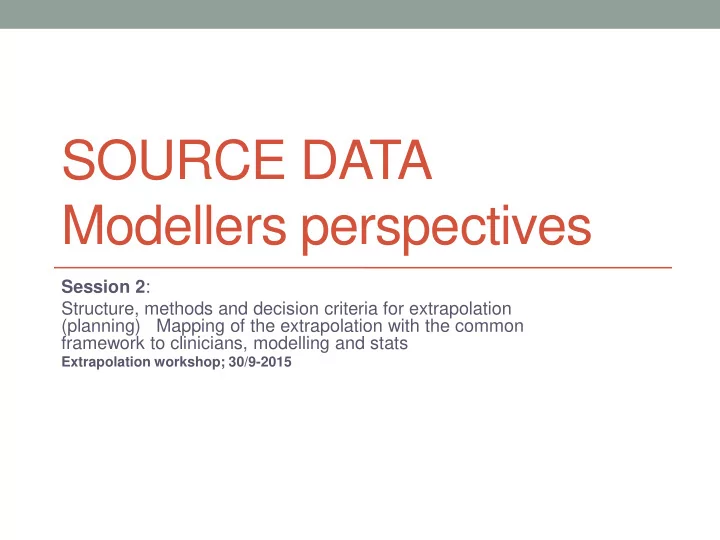

SOURCE DATA Modellers perspectives Session 2 : Structure, methods and decision criteria for extrapolation (planning) Mapping of the extrapolation with the common framework to clinicians, modelling and stats Extrapolation workshop; 30/9-2015
Sources of data In general; all data relevant for describing the interplay between the drug, organism and disease (“systems data”) Useful sources of data include • Clinical data • Adult clinical data on drug in question • Paediatric clinical data on drug in question • Clinical data on same drug in other conditions • Clinical data from other similar drugs in same condition. • Non clinical data • In vitro data/ Physiochemical drug data • Data on biology, physiology, pathophysiology etc The sources needed will generally depend on the approaches taken • Need to outline the potential sources per approach? • Is there a need to set general requirements?
Inform transitions Relevant levels of transition in paediatric developments: • Inform clinical study design or replace a study • Source to target population • adult to children • between children of different age groups • animal to human • physiochemical and in vitro to in vivo • Dose to Exposure • Exposure to Response • exposure to PD endpoint/biomarker • PD endpoint/biomarker to clinical efficacy and safety endpoints
Dose Exposure Response approaches Clinical Data/ POPPK or PBPK POPPKPD or systems models time course models Concentration/amount Signalling of active D rug in effect Response + R D-R pathway/ compartment endpoint MOA Disease status Concentration/amount Biomarkers of active drug in central Dose Disease progression (measureable) Maturation... compartment Placebo effect Compliance Covariates: Disease Size Study methodology Co-medication kel (DDIs) Maturation... Sample power Nutrition Formulation Covariates: Pharmacogenetics Other… Disease Ethnicity Co-meds Nutrition Safety Formulation PGx endpoint Ethnicity Dose Exposure PD Efficacy and safety Response Different data sources and confidence in the data.
Tool box for pharmacological M&S Top-down Bottom-up Population PK and PD PBPK and PD Bayesian Systems pharmacology Combine methods to use all existing knowledge Clinical trial simulations to optimize trial design
Population PKPD- Data sources Primary data source : Clinical data: Pharmacokinetics Pharmacodynamics Covariate data Supporting data : Possible determinants of Inter-subject Physiological data: on clearance, Vd variability: and F to support PK model Age, Body Weight or Surface Systems data/ in vitro data to support Area, gender, race PKPD model Genetic: CYP2D6, CYP2C19 Factors linked to variability Renal (Creatinine Clearance) or Assumptions Hepatic impairment, Disease State Uncertainty Concomitant Drugs Other Factors: Diet, Circadian Variation, Formulations
PBPK/System modelling System model Drug specific parameters Anatomy ADME, PK, PD and MOA Biology Metabolism Physiology Active transport/Passive diffusion Pathophysiology Protein binding Patient/disease extrinsic factors Drug-drug interactions Receptor binding 7
Systems models - data sources Property In silico In vitro In vivo Drug dependent Drug and dose form properties Physiological data √ √ √ parameters Log D √ √ Acid or base √ √ pKa • Variety of sources √ √ √ • Variety of sources Solubility • Historical Drug distribution parameters • Non standardised in √ √ Plasma protein binding • Data often lacking √ √ vitro assays Blood/Plasma partitioning • Populations in software • No incorporation of √ √ Microsome binding reflect variability in √ √ √ variability Permeability physiology/ enzymology. √ √ √ Tissue Kp’s • Complex pathways Pharmacokinetic parameters √ √ √ Volume of distribution √ √ √ Plasma clearance √ √ Clearance (renal) √ √ Clearance (metabolic) √ √ Clearance (active) √ √ √ Oral bioavailability √ √ √ Gut extraction √ √ √ First pass hepatic extraction Pharmacodyamics- Multiple pathways √ √ √ Vmax √ √ √ Km √ √ √ Time dependancy
Extended time course models Limited longer term clinical data: • 1358 patients at 12 weeks Extensive clinical data • 270 patients at 60 weeks • 5102 patients • 89,760 patient years of data
Conclusions • The source of data depends on the transition being made and the approach being used. • All data should be considered that describes the interplay between the drug, the subject and the disease. • Requirement for transparency about the source of the data. • Systems modelling is important for a thorough mechanistic understanding but uncertainty around many parameters.
Recommend
More recommend